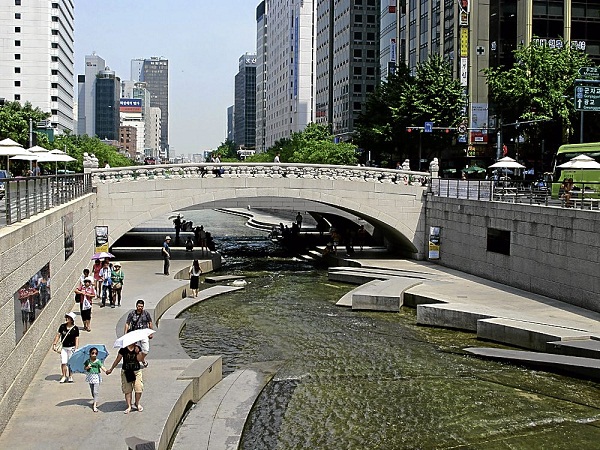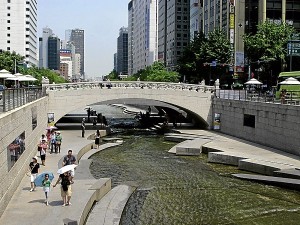
It was from a weekly news magazine that I first learned about the saga of Cheonggyecheon, a stream in downtown Seoul.
The antecedents of the action begin in the aftermath of the Korean War, when many of those displaced by the destruction of the countryside started moving to the city. A number lived in shanties along Cheonggyecheon, using the rivulet to dump garbage and household waste.
So dismal was the squalor that it was decided to simply cover the entire mess with concrete. This entombment process would go as far as the construction of an elevated highway, completed in the 1970s.
By the end of the 20th century, it would have been impossible to guess that, beneath the pavement, a brook once sang.
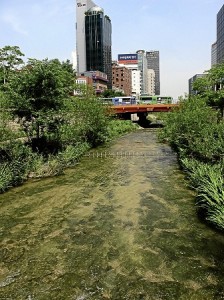
Around 2003, the mayor of Seoul, Mr. Lee Myung-bak, began a renewal program which would cost hundreds of millions of US dollars. Among his proposals was the setting up of an urban forest. Another was to revive the lost stream.
At first, many questioned the quixotic undertaking, which required the removal of putrid debris as well as thick layers of concrete.
Hundreds of thousands of tons of water also had to be pumped in from the nearby Han River. Some worried that traffic congestion would worsen. Many meetings had to be held with the area’s residents who would be resettled.
After Cheonggyecheon’s reopening in 2005, however, the mayor would be vindicated: The people embraced the project.
Tourist draw
It is now a major tourist attraction of the city, earning for Seoul the reputation of being a green metropolis. About 90,000 visitors are said to enjoy the site each day.
The blog “Urban Guerrilla” lauds the fact that the riverside corridor has become a place where citizens from all walks of life are able to mingle, encouraging greater interaction as well as strengthening community spirit.
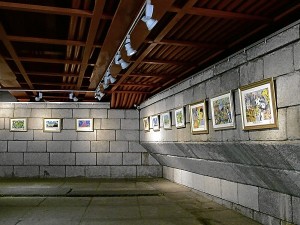
This interaction is essential in cosmopolitan life because, as the website explains: “The city… functions as a collective whole with emphasis on the relationships between the various components within it, creating an urban narrative that gives meaning to its people. The existence of public open spaces therefore becomes an important component in stitching the city together.”
Bonus
Strolling along the fluvial walkways, I could easily see why Cheonggyecheon is so popular. It is such a bonus to happen upon a haven filled with the rustling of leaves, cooling breezes and birdsong amid the metropolitan bustle.
What I found even more amazing was the fact that, though it must have been so complicated to remove the cement and setup the channels from the Han River, the result is deliciously simple.
There were no hideous lamp posts with multicolored light displays, no gimmicky and grotesque park benches.
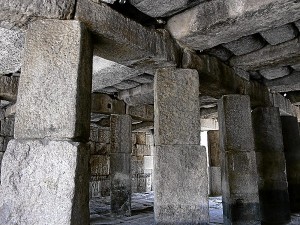
There was no elaborate landscaping using botanical imports from foreign lands. The plants which line the banks are like those found along any country stream: weeds and reeds, the occasional bush. I was actually surprised to be so relieved that there was not a single Indian candle tree in sight!
Water itself was obviously the real star here. Bubbling, flowing, eddying in mysterious pools, laughing at the butterflies, reflecting the sky above, it was truly a joy to behold, an undeserved fluid pleasure amid the sunless warrens of the big city.
I could see old men wading and children delighting in each wet handful. I could see couples sitting, quietly drinking in the silence.
I recalled how, while we were traveling in Western China, our tour guide rattled off the histories of temples and villages gliding past. The other Filipinos in our party were so tired that they were not really listening. Then someone called out: Look at that river! See how clear the water is!
Suddenly all the Filipinos were alert, crowding the windows, straining to catch a glimpse of this incredible sight. Sad as it sounds, it cannot be denied: Clear water is indeed a cause for marvel in the Philippines!
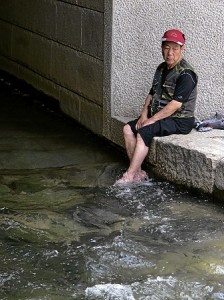
After being lost in all the liquid magic of Cheonggyecheon, I pulled back a little and began to notice interesting details. There was actually a lot more that had been carefully added to maximize our riverine delight.
I noted that even the paths we were walking on had been engineered for variety. There were smooth and rough surfaces, wooden planks employed along with stone.
I noticed that in several places, rocks had been set into the water so that one could cross. I thought this detail made complete sense: Those negotiating the banks may, after all, want to check if the grass was indeed greener on the other side of the stream!
Heritage
Heritage elements were part of the mix of old and new. There was a time-worn bridge with its original carvings still intact. The walkways passed under the span so that one could even examine the massive structural supports from below.
The granite walls covering the banks were not all uniform—some sections had blocks which protruded unevenly.
This was clearly no accident, but was purposely done to evoke the feeling of ancient castles and fortresses, making for a richer experience.
Other walls boasted ceramic murals based on antique scrolls, as well as decorative works commissioned from contemporary artists.
Aside from aesthetic elements, one could appreciate the concern for public safety and comfort. To reach the river promenades, pedestrians may choose between using elevators or wooden staircases.
There were signs everywhere explaining the layout of the general area or providing historical information. I saw that there were even provisions for posters on cultural events around the city.
I was especially impressed to find that a space under one of the bridges had been converted into a gallery displaying paintings by children. Clearly, whoever planned this project was taking into consideration a wide range of uses and needs.
Perhaps the only discordant item was a wishing well incorporated into the stream bed. A nearby sign urged the passerby to throw in a coin for the instant gratification of unbridled desires. One, alas, will encounter such devices everywhere in the world these days.
Though there is always the assurance that all money collected will go to a charitable cause, these wells are nevertheless eloquent reminders of a consumerist world that is ever-ready to capture the cash of the unwary.
Seoul definitely takes pride in the mayor’s sparkling gift. The district around the stream is now bustling with many chic establishments, such as museums and cafes.
Since the area is very well-lit at night and is patrolled by friendly police, one can enjoy this oasis all day long.
While walking along the water one evening, I was impressed to see impromptu concerts springing up as well as a night market. Likewise, I noted that several of the nearby skyscrapers have incorporated features like fountains and other aquatic references in their streamside frontages.
Contemplating Cheonggyecheon, I thought about how this was a project that could, someday, be replicated in the Philippines. Gina Lopez was certainly taking a similar tack with her efforts to resurrect Manila’s esteros.
Wouldn’t it be wonderful if more public officials would follow her example and assist her programs? If they did, they certainly would have a significant incentive: Seoul’s stream-reviving mayor has since been voted President of Korea!
Turning this over in my mind, an idea suddenly struck me. I went back to the wishing well and threw in a coin, all the while imagining a Pasig River that is alive and brimming with clear—yes, clear!—water.
Who knew if my wish would come true? But it was definitely worth losing a bit of cash for!

